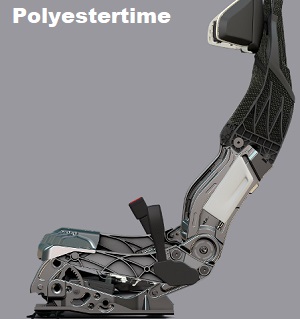A power swivel seat and a shape-shifting instrument panel are transformative technologies being developed for autonomous vehicle interior environments.

The multi-material advanced versatile seat structure was developed Faurecia and ZF. (Faurecia photo)
“We’re taking classical products and materials and adding another layer of technology that results in new features and new functions for the user experience inside an autonomous vehicle cabin,” said Robert Kinney, Vice President of Engineering for Faurecia’s North American Operations.
Kinney and other Faurecia technologists spoke with Automotive Engineering during a recent program showcasing near-term products at the supplier’s North American headquarters in Auburn Hills, MI.
With its electronically powered 60-degree recline position and 15-degree swivel, the advanced versatile seat structure is the first functional demonstrator developed by Faurecia and ZF engineers through a partnership that formed in 2017.
According to Troy Ziemba, Faurecia North America’s Director of Metals and Mechanism Applications, virtual validation via FEA indicates that the structure’s swivel position meets the suppliers’ initial projections for seat integrity and occupant protection for a frontal crash.
With a conventional 12-V motor, the structure doesn’t yet have optimal speed to reposition the occupant from a 60-degree angle to the validated angle of 45 degrees, said Ziemba. “We’re working with ZF to define a safety sphere that factors in the recline angle, the speed of seat movement, and other aspects to put the seat frame in a proper position prior to a collision,” he explained.
The multimaterial seat structure’s upper back is a made of nylon 6/6 with glass fiber and a pre- formed glass mat. “What’s unique about the upper back is that it’s a plastic composite that can withstand all belt-to-seat loads,” said Ziemba.
SAE Level 4 and 5 autonomous vehicles likely will have fore and aft seat travel in the range of 800 to 1000 mm (31.4 to 39.3 in) vs. traditional seat travel of 250 to 270 mm (9.8 to 10.6 in). “If the seat reached its maximum rearward location with a B-pillar-mounted seatbelt, that ‘far, far away’ shoulder belt would be rendered ineffective,” Ziemba said, underscoring why the concept structure’s pretensioned seatbelt and tube-enclosed retractor are frame-mounted.
Airbags are located on the structure’s inboard and outboard sides; a backside structure-mounted airbag protects the rear seat occupant. The power head restraint’s track is also integrated into the seat back frame.
Back frame side members are made of dual phase steel with certain sections being less than 1 mm (0.039 in). Structure linkages and riser brackets are made of high strength steel (HSS). The cushion pan and cushion side member are made of die-cast aluminum. “To get the necessary bend radius with dual phase or HSS, the cushion side member section would have been 15-20 mm (0.59-0.78 in) higher than the die cast aluminum side member. It was important to achieve an optimized block height,” Ziemba said, referencing the distance from the seat’s mounting point to the occupant’s hip-point.
The swivel mechanism and other subsystem elements of the versatile seat structure are slated to production-debut as early as the 2020MY.
While the advanced versatile structure enables seats to swivel and recline during an autonomous driving experience, the traditional dashboard can be transformed during SAE Level 4-5 autonomous driving. “The whole cabin is an envelope that we have to address as a complete ecosystem,” Kinney said.
The shape-shifting IP features a 600 mm (23.6 in) wide and 200 mm (7.8 in) tall TFT display screen. In the non-autonomous driving mode, the display shows vehicle speed and other information directly in front of the driver. But in full autonomous driving mode, the screen slides to the driver’s right as the flexible membrane IP simultaneously changes its shape via electro- mechanical mechanisms actuated by capacitive touch control switches in the demonstrator’s natural wood accent trim.
Kinney noted that the demonstrator IP can move approximately 60 mm (2.36 in) in the vertical direction moving the IP surface lower over a span of nearly 500 mm (19.6 in) at the dashboard’s midpoint. The morphing IP is slated to be production-ready in 2020.
Related Topics
Seats instrument panel Faurecia autonomous vehicle Seats instrument panel Faurecia autonomous vehicle Seats instrument panel Faurecia autonomous vehicle Seats instrument panel Faurecia autonomous vehicle Seats instrument panel Faurecia autonomous vehicle Seats instrument panel Faurecia autonomous vehicle
